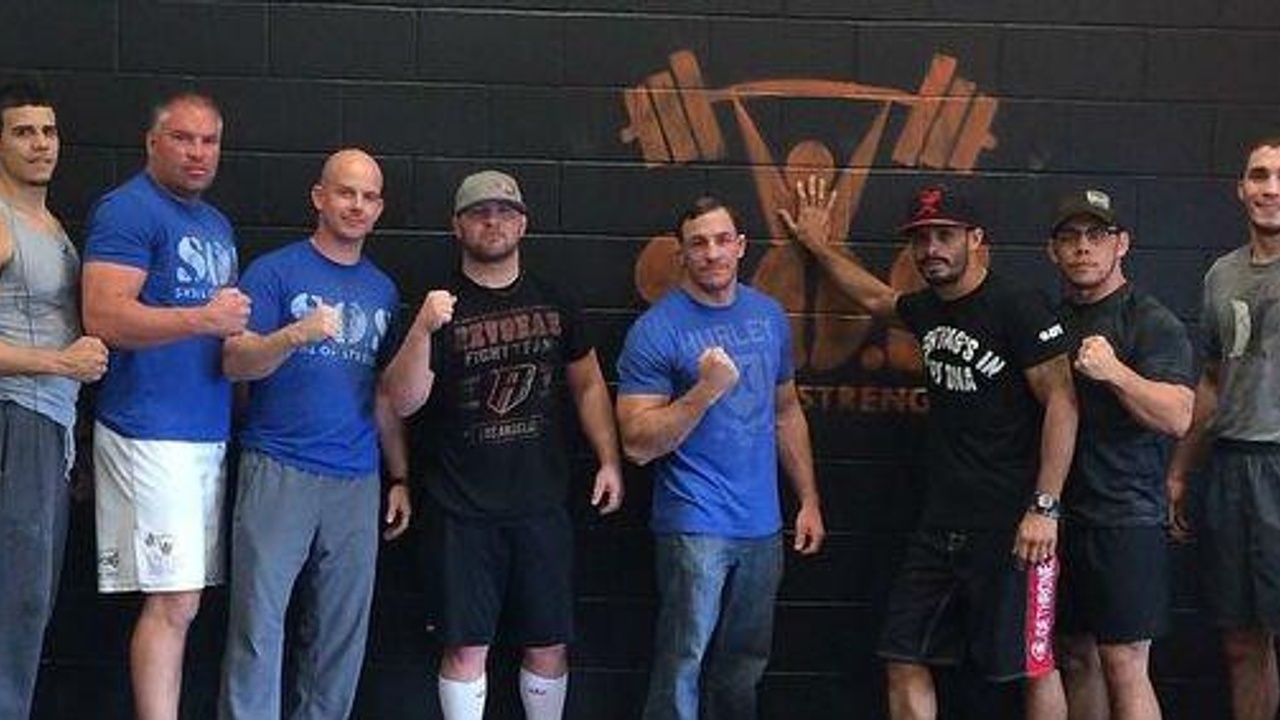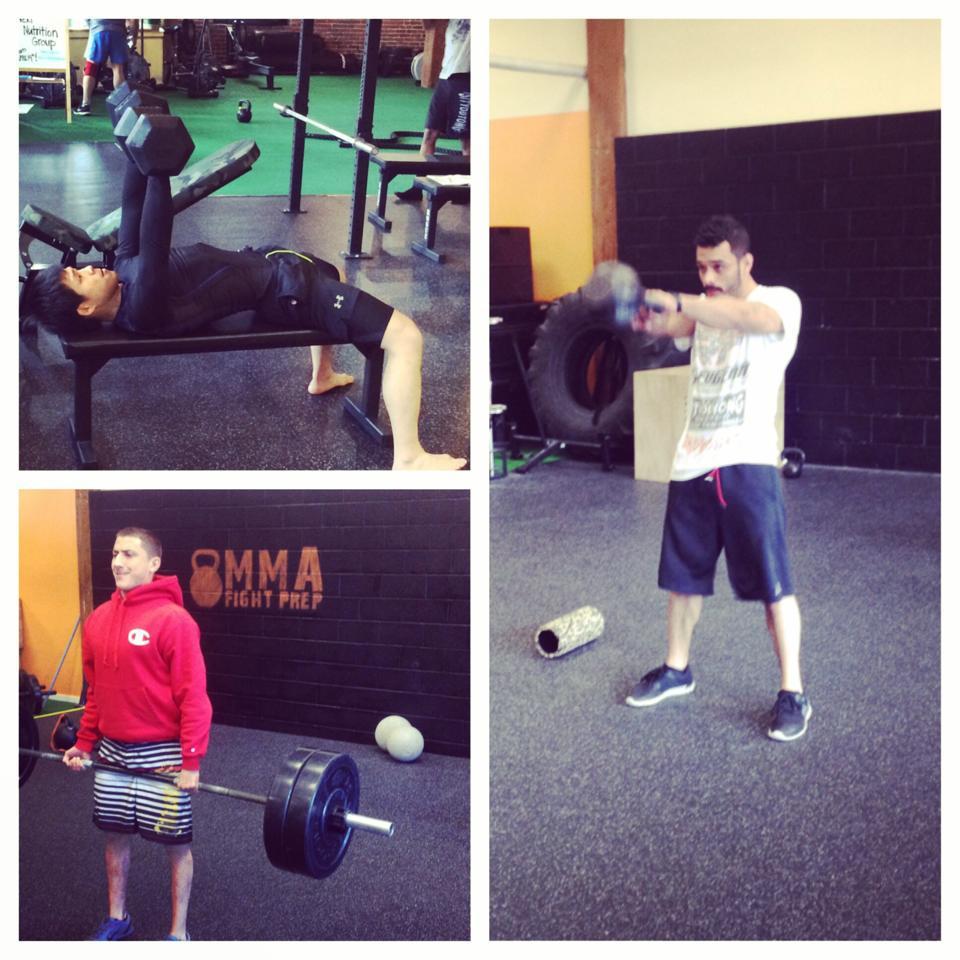
Road Work, Kettlebells and Sprints: Good or Bad for Fighters?
by Mike Perry
I hear these questions all the time:
What do you think about running for fighters?
Me: It depends
Do you use kettlebells with your fighters?
Me: It depends
 Are wind sprints, suicides, shuttle runs etc. good for conditioning?
Are wind sprints, suicides, shuttle runs etc. good for conditioning?
Me: It depends
I am not trying to sound like a jerk answering these questions this way, but it really does depend on the athlete. I need to know so much more about the athlete(s) in question before I give you an accurate and “safe” answer to any of the above questions about training fighters.
By “safe,” I mean that the exercise cannot injure an athlete. Put it this way, if my athlete rolls his ankle while changing direction in a fatigued fashion, it’s on me. Sure accidents happen, but as coaches, we need to “do no harm” and make sure our athletes are training as safely and effectively as possible.
So, what exactly do I need to know in order to answer whether running, kettlebells, wind sprints, suicides, etc. are good for fighters?
 Running (long distance/steady state)
Running (long distance/steady state)
Running is old school. There is nothing wrong with old school. However, I do have some issues with running. Like any athletic movement, running is a skill and athletes need to practice running correctly before they can attempt to use running as a conditioning tool.
Before you, as a coach, prescribe running to a fighter, you need to know if he/she moves well.
You should already have the answer to this question if you performed a quality assessment. I’m a huge fan of the Functional Movement Screen as it’s an excellent way to get a movement baseline.
Here are a few examples of common restrictions:
- If an athlete has decreased ankle mobility, specifically dorsi-flexion, it is going to alter his/her gate and could present some pretty nasty compensations. The issues normally present themselves in the trail leg. The decreased ankle mobility will force the athlete to externally rotate at the hip and potentially increase the stress on the medial part of the knee.
- Another issue I see with athletes is that they are not able to extend their hip properly without extending their lumbar spine simultaneously. This could be due to an excessive anterior pelvic tilt, poor anterior core strength, or just restrictions in their hip flexors/quads. Regardless of what the issue is, it’s important to get athletes to the point where they can recruit their posterior chain without compromising the integrity of their lumbar spine and pelvis.
- Find out if an athlete has run in the past. What was his/her experience? Did it help him/her get fit? Increase aerobic capacity? How did they feel overall? This is all vital information. It may not be wise to ask a heavyweight to go out for a 45 minute run if they have never run in their life. Keep in mind, there are plenty of other ways we can train the aerobic system. Running may not be a great choice.
- What does the athlete’s foot strike look like? Where does he/she land? Midfoot? Heel striker? If an athlete is indeed a heel striker, running might not be a good choice for now. Can you clean up technique and teach him/her how to midfoot strike? Sure, but how much time do you have to correct this? Is it time worth investing?
Kettlebell training
I am a huge fan of kettlebell training. I’ve been training with kettlebells since 2006 and I currently work for Pavel Tsatsouline’s company, StrongFirst, as a kettlebell and barbell instructor.
While I am a huge fan of kettlebell training, I understand that it’s not for everybody.
If you do want to incorporate kettlebell training with your fighters, make sure they can:
- Touch their toes.
- Stabilize their lumbar spine, pelvis and ribcage.
- Extend their hips without hyper-extending their lumbar spine.
- Own a good active straight leg raise pattern. In the FMS world, this would be a score of 2/2.
If your fighters cannot do the things in the list above, the kettlebell swing will eventually bite you in the ass and you guessed it, your fighters could potentially get injured.
If you want to use the kettlebell swing as a tool, great! Just make sure your fighters own the prerequisite movement patterns first.
So you are a 2/2 on the active straight leg raise and you can touch your toes, what’s next?
1. Learn the pattern (hip hinge). The hip hinge or deadlift pattern comes first. A great way to pattern this is with a dowel placed vertically on the spine. There should be three points of contact, the back of the head, upper back, and sacrum. As an athlete moves into the hinge, the goal is to keep the dowel touching those three locations through the whole movement. You can also add in the biomechanical breathing match at this point. Breath in through your nose as you hinge, and “hiss” air out when you perform the lockout.
Once your athletes nails 50 of these perfectly, its time to move on to the kettlebell deadlift!!
2. Grind the pattern (slow strength). The kettlebell deadlift is a perfect way to train the hip hinge with an external load. A few new things are added into the equation during the kettlebell deadlift – grip, lat tension and enough core strength to resist spinal flexion or hyper-extension. A great way to train the kettlebell deadlift is in multiple sets of 5 reps.
The kettlebell deadlift will reinforce technique and keep fatigue at bay. PLEASE don’t overlook this step! If you cannot deadlift the kettlebell correctly, the swing should not happen!
3. Swing practice (ballistic practice). You might notice that I used the word practice instead of the word train. I did this purposely. I’m a firm believer that we need to acquire skill before actually using the exercise for metabolic purposes. In kettlebell swings, the hips drive the kettlebell and the arms guide it. The kettlebell swing is a projection of energy, and the timing of the swing is incredibly important when it comes to moving the kettlebell safely and efficiently. Here is an older blog I wrote about the importance of “timing” in kettlebell swings.
Newtons Cradle and the Kettlebell Swing
Like anything, it’s important to start with the basics. Once a fighter masters the swing, he/she can add in a clean, a snatch and later progress to double kettlebell work.
 Wind sprints, suicides, shuttle runs etc.
Wind sprints, suicides, shuttle runs etc.
Most people would agree that sprinting can be an incredibly effective tool for athletes. From a neurological standpoint, I would argue that sprinting takes the highest level of strength, coordination, and stability over any other exercise that can be performed without an external load.
That being said, it’s important to make sure an athlete is ready to sprint, cut and change direction quickly and violently.
Here are a few things to consider:
- Has the athlete ever performed these exercises in the past? When is the last times he/she actually sprinted? In high school? College?
- How is the athlete’s weight currently? Fight weight and off-season weight are very different. If a fighter is 20lbs heavier than normal, his/her ligaments, joints, etc may not be ready for this high intensity work!
- Can the fighter decelerate his/her body correctly when it comes to changing directions? Can the fighter change direction using both legs?
- What shoes is the fighter wearing? Multi-directional movement training in Nike Shox is about as effective as going to the bathroom with your pants still on.
I must repeat, athletes need to develop skill in a given exercise before using the said exercise for "conditioning" purposes. Develop capacity first, intensity second!
Asking an athlete to perform "suicides" without the necessary skill is like asking him/her to fight without knowing how to throw a punch.
There is no such thing as a bad exercise. Exercises are only bad when they are applied improperly, progressed far too quickly or given to someone before he/she has the prerequisite mobility and/or stability.
As always, train smart and train hard!
Mike is the founder and co-owner of Skill of Strength, a performance-based training facility located in Chelmsford, MA. Throughout his ten-plus years as a Strength and Conditioning Coach Mike Perry has trained clients of all ages and abilities, including elite athletes represented in the UFC, NCAA, NFL, MLB, MLS, Bellator MMA, CES MMA and several other New England MMA promotions.




